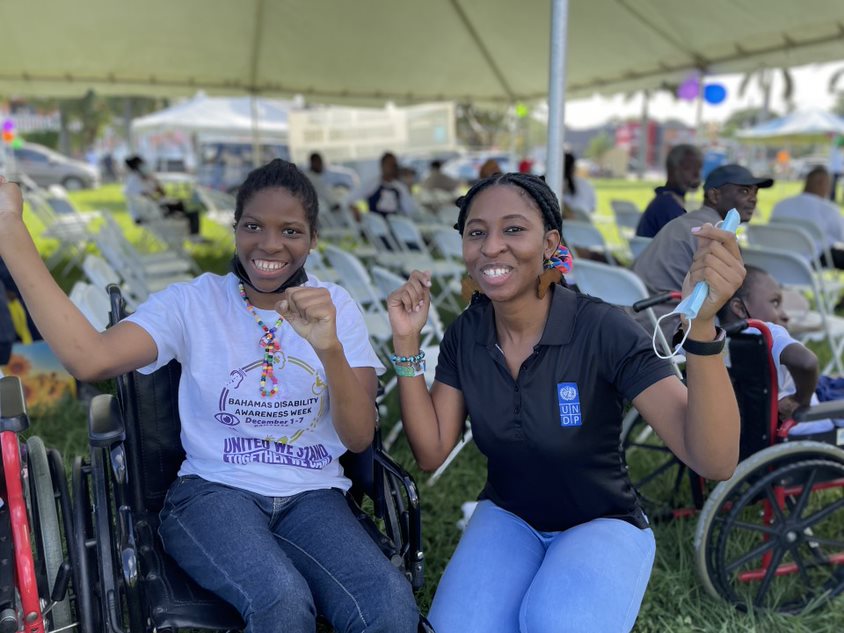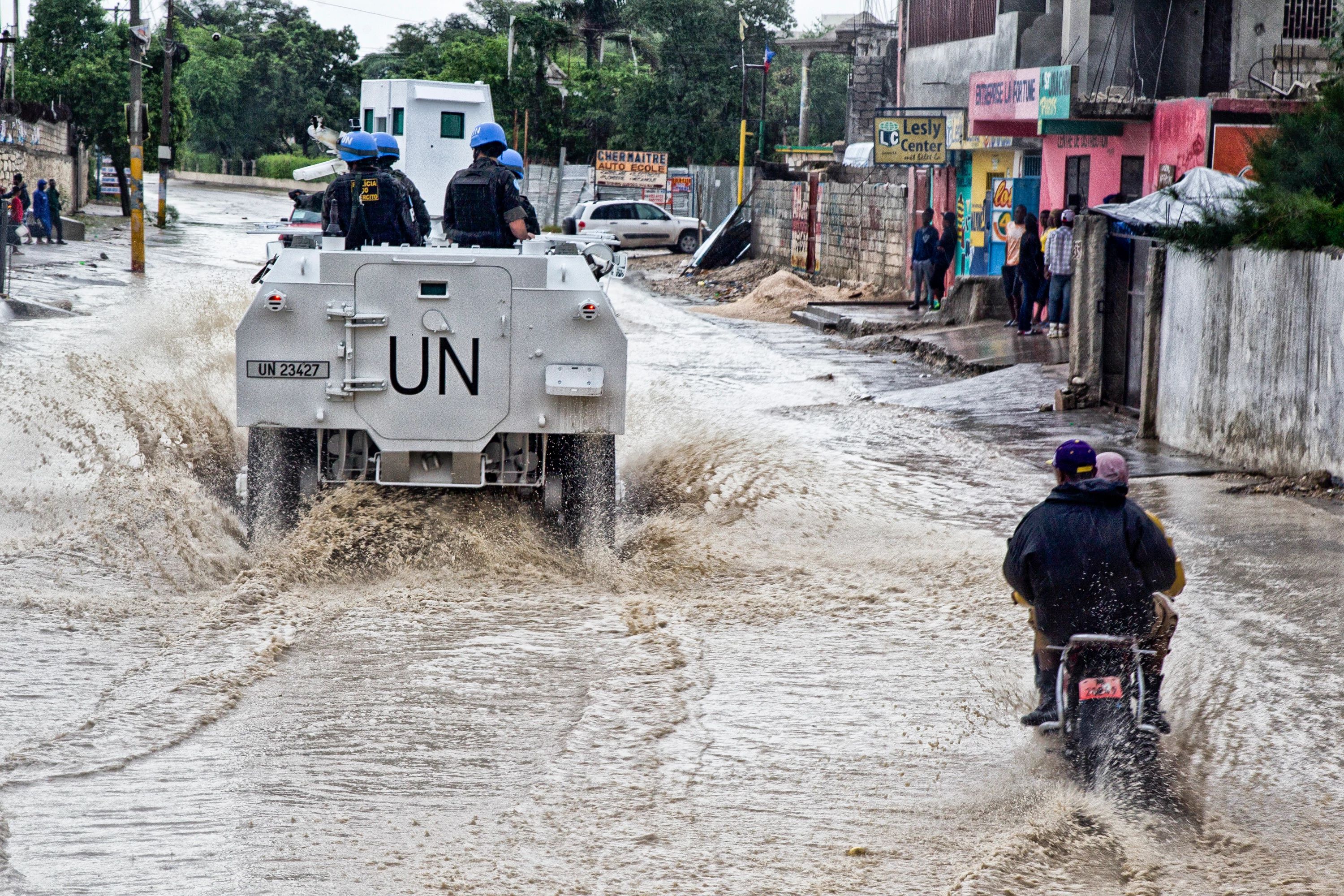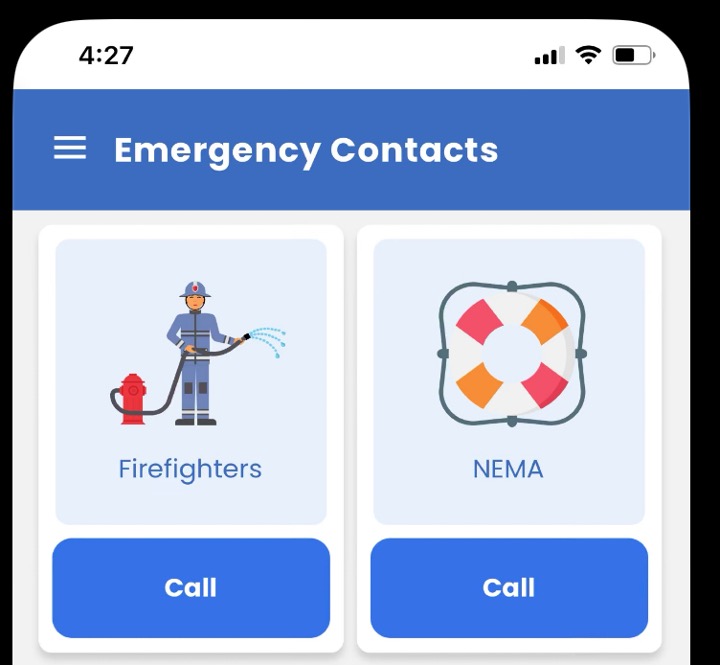On World Humanitarian Day, learn how UNDP Multi Country Office in Jamaica is supporting The Bahamas in making Early Warning Systems accessible and inclusive of the needs, perspectives and priorities of persons with disabilities, so no one will be left behind in times of disaster
We can replace things, but we can’t replace people: protecting lives through inclusive early warning systems in the Bahamas
August 17, 2023

A young girl with disability and UNDP team member Abby-Gale Clarke commemorating Together for Disabilities Week festivities organized by the National Commission for Disabled Persons.
This blog series by the Crisis Bureau Disaster Risk Reduction Team highlights promising practices showcasing how UNDP and its partners are promoting the inclusion of persons with disabilities in initiatives for building the resilience of communities and nations to the risks and impacts of disasters and climate change
When Hurricane Dorian finally passed over the Bahamas archipelago in 2019, 74 people were dead, hundreds were missing and almost 30,000 people were homeless and/or jobless. The 48 hours of 220 mile per hour gusts of wind and 20-foot storm surges also caused 3.4 billion USD in damages, equivalent to a quarter of the nation’s GDP. Thinking back to the Category 5 hurricane, Mr. Roberts eloquently said that “We can replace things, but we can’t replace people”. Mr. Townsley Roberts is the Deputy Executive Secretary of The Bahamas National Commission for Persons with Disabilities and has a disability himself. “We need to ensure that we can locate persons with disabilities before, during and after disasters. We found that a great challenge during Hurricane Dorian”, he continued.
The Caribbean region is highly exposed to natural hazards such as hurricanes, floods, volcanic and seismic activities, droughts and forest fires, and these are being intensified by the increasing impact of climate change. “We must prepare for what is fast becoming the new norm – increasingly powerful and destructive storms that illustrate the harsh reality of climate change”, explained Denise E Antonio, UNDP Resident Representative for six Caribbean countries, including The Bahamas.
To protect communities from these disasters, different strategies and tools, including Early Warning Systems are deployed to raise awareness of climate-related events that increase the risk of lives and livelihoods being destroyed. Yet many such systems are typically not accessible and inclusive of persons with disabilities. For example, Early Warning Systems that use SMS to target a population en masse often do not consider the need for different formats and features for users with disabilities such as how a text message warning may not be accessible for a person with a visual impairment. Governments must proactively plan and implement measures that consider the needs of all individuals, fostering their meaningful participation in disaster preparedness planning efforts and Early Warning Systems to lessen the impact of disasters.

Early warning systems enable people to move out of harm's way and protect their families and livelihoods, but for persons with disabilities, inaccessible early warning means they can miss these early alerts, putting them directly in harm's way. Even when they learn about an oncoming disaster, it may already be too late to evacuate
Bringing AccessAbility to early warning systems
As part of the UNDP’s Digital Access for All Bahamas Project, the UNDP Multi-Country Office of Jamaica, The Bahamas, Bermuda, The Cayman Islands and Turks and Caicos Islands, located in Jamaica, partnered with the Bahamas National Commission of Persons with Disabilities to upgrade and expand the AccessAbility app, which protects communities from disasters by providing a range of services including alerts, sign and translator services, job postings and more. The app, launched in December 2022, has accessible features, such as digital disaster alerts from the National Emergency Management Agency, one-touch access to emergency services, and bus route displays and street-by-street movement guidance to help orient affected community members during evacuations. The key feature for saving lives is the mapped location of registered users with the National Commission. Knowing the precise location of registered persons with disabilities means the National Emergency Services can begin evacuating persons with disabilities once warnings are issued.
The app was created with input from persons with disabilities from inception to launch. Abby-Gale Clarke, from the UNDP Multi-Country Office in Jamaica, explains how “from the first phase of the app design, persons with different disabilities were a part of the consultation and the same followed for the design phase to the implementation phase”. Persons with diverse functional limitations conducted user testing to provide feedback and gauge if the app was suitable and accessible to everyone. Currently, there are 165 active users and promotional videos have been created with paralympic athletes Vasnhi Thompson and Michael Miller to increase awareness of the application and engage new users.
"This app is so important because it helps facilitate accessible communication as even our news channels are not accessible due to the unavailability of closed captioning, and not all stations have someone to sign,” said Mr. Roberts.
As many TV channels are not accessible, climate warnings and disaster alerts can be missed by persons with disabilities. AccessAbility closes this information gap through the alerts which will be sent directly to users' phones, ensuring that persons with disabilities can receive timely updates and alerts about imminent risks, regardless of their location or disability. The alerts provide details on the expected time of landfall, storm surge tracking, continuous updates about the safety of leaving shelters and returning home and where to go for food or medical assistance. The app is critically important as common experience reveals that persons with disabilities are more likely to be left behind during evacuations in disasters due to the lack of adequate preparedness and planning.
The Commission also works closely with National Emergency Management Agency inspecting emergency shelters to ensure their accessibility, and writing reports on changes to be made when they are not deemed suitable. When verified and approved, the shelters will be uploaded on the app, meaning when disaster alerts are issued, persons with disabilities can immediately check where the nearest and most accessible shelter is for them.

A screenshot of the app’s one-touch emergency contact page
Closing the protection gap for persons with disabilities
Alerts transmitted by the app are operated on the same system as National Emergency Management Agency alerts, meaning “each person, no matter what island they are on, will have constant updates on the app, 24/7, whatever is needed”, Mr Roberts explained. UNDP’s Abby-Gale Clarke shared the plans for the future of the app, which include enhancing the transport routes for the more remote islands of The Bahamas, and expansion to other Caribbean nations. As disasters have a disproportionate impact on persons with disabilities, technology such as the AccessAbility app could be the key to unlocking a safer future for all.

 Locations
Locations